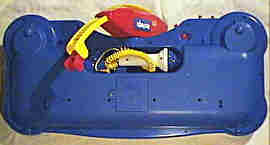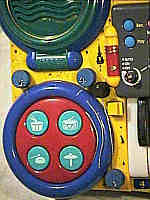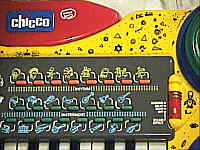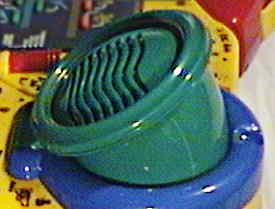| Chicco - Sing 'n' Dance Orchestra | pretty toy keyboard with key lighting, nice tekkno sounds & demos |
This quite big toy keyboard is one of the most versatile My Music Center successors. It has 4 note polyphony, many sounds and demos and a unique case design. The strange tube speakers can be folded upward, there is a primitive pitchbend dial (behaves like a button press, fixed speed) and the thing has even key lighting, although this one behaves way more primitive than e.g. on Casio keyboards like ML-2. It is nicely usable for tekkno although like most such instruments it has various restrictions and unfortunately a quite short keyboard.
The initial German retail price (99DM, about 49€) was quite high for a toy keyboard made in China, thus it may be that this thing is quite rare now so far only few people bought it. At least on eBay (where I got mine) they don't appear often.
 |
 |
 |
 |
 |
 |
 |
| British, USA | : Sing 'n' Dance Orchestra |
| Italian | : Super Orchestra |
| French, Greek | : Super Piano |
| German etc. | : Super Sound Piano |
The keyboard of it responds a bit sluggish (especially with clock speed pitched down); pressed keys of currently playing notes light up, which nicely indicates when the instrument runs out of polyphony. A bit annoying is the "auto power- off" feature, which mutes the instrument with a quiet short beep when no key is pressed for a minute and then delays the next note while it comes up again with a popping noise. After multiple minutes of inactivity, the instrument resets when any key or button is pressed. Annoying is also that lit key LEDs beep in the amp by data line crosstalk. Like with most such keyboards, all buttons play a beep or preset sound, which is intuitive but also disturbs live performance. The drumpad buttons initially made mess when pressed with held notes; solder a diode into each drumpad line to fix this. An odd feature is that this instrument has a dedicated "reset" button; apparently the designer expected that it would lock up by known or unknown bugs. The button can be also abused musically by holding keys and a preset sound button and then trilling on "reset", which makes a funny tekkno strum sound. After reset or power- on the instrument normally plays a jingle and a walking light pattern appears on the keys. Strange is that when the instrument is switched on after a while, often instead of the jingle and light pattern only the 1st key lights up with a static buzzing noise, and when any key or button is pressed, the lowest and longest possible "piano" note sounds and then the key unlights; afterward the instrument behaves normal.
The "instrument" preset sounds have the same gritty synthetic lo-fi chorus style like My Music Center, but unfortunately they are programmed differently (a bit more natural) and thus the great harsh "trumpet" and "guitar" are gone. All timbres have a volume envelope with well audible ticking zipper noise and most contain a chorus effect with slow tremolo. The "piano" sounds the same (honky- tonk- like), "organ" resembles a metal pipe organ rank; "pipe organ" is a bit duller with slower attack rate. "violin" is also like My Music Center; "viola" is duller, 1 octave lower and has shorter sustain. "trumpet" resembles "organ" on My Music Center and resembles more an accordion. The "mandolin" rings fast. "bell" has a slow attack rate and resembles a bowed glass which slowly fades silent. The "e-bass" is quite dull and the "guitar" resembles an acoustic one. The "musicbox" resembles more a Rhodes piano. The "banjo" sounds harsh with too long release phase. The "clarinet" sounds a bit dull (no chorus effect). The "tuba" resembles "violin", but is duller with long sustain. The "cello" sounds low with long sustain. All sounds except "clarinet" employ a chorus effect and all have some sustain, thus no very short tones can be played.
The effect preset sounds are very short and grainy very low resolution samples (without loop point) and have barely to do with their icon but are nice tekkno noises. The "cat" is somewhat percussive and metallic. The "spring" could be also a frog. The "whistle" is rather a bird tweet. These sounds only play monophonic, and when multiple keys are pressed they often strum the played notes instead. I don't understand why these samples only play monophonic while normal sounds are polyphonic; the only thing I can imagine is that the CPU can access its internal ROM address space only in small chunks by bank switching, and the effect samples are in a different bank and occupy there so much space that the polyphonic keyboard scanning algorithm didn't fit into it and thus was replaced with a shorter program code that only permits monophonic play.
The "sound effect" switch adds to the main voice nice lo-fi effects those are great for tekkno. The "echo" effect chops the played notes through a gate effect with about 3.5Hz. Because the gate is polyphonic and the phase of its switching frequency depends on the note start time, you can create chords with interesting pulsing textures by varying the note timing of long notes. (Another keyboard for such textures is the great Casio SA-35.) The "delay" effect simply sets all note lengths to the fixed duration of 2 seconds (also visible on the lit key LEDs); no longer or shorter notes can be played in this mode. The "rubbing" effect activates the pitchbend dial.
Despite it contains a potentiometer, the pitchbend dial behaves only like a digital switch contact that makes the note pitch ascend when closed and descends the pitch of notes for 0.5s when opened again. (The dial can be turned clockwise by 90° and returns by a spring.) The pitch ascends or descends always with a fixed rate and maximum for 3s (with about 1 note per second) and has audible zipper noise steps (almost a glissando). The behaviour is very different from a normal pitchbend wheel and also different from the Sankai 01504H pitchbend feature. It makes various strange glitches; when new notes are played with held dial, normally the 1st note ascends while later notes often don't. Because it bends notes rather slow and still bends them down 0.5s after dial release, it is rather a howling tekkno effect than a musically well usable pitchbend controller. The pitchbend also affects the rhythm accompaniments and the tom and cymbal sound of the drumpads.
The 8 rhythms are switched on by individual OBS buttons; annoying is that rhythms always start with their default tempo and you can only switch a rhythm off by pressing its button again. When you don't remember the current rhythm and press a wrong button, the rhythm of that button starts instead. All rhythms beside the african one contain a fixed- key accompaniment that can not be disabled, which makes them rather useless for melody play. Strange is that some percussion sounds of the rhythms disappear as soon any note is played while the "rubbing" effect is activated; apparently one of the rhythm tracks is muted to free a polyphony channel (switching "rubbing" off re- enables the track).
When the power switch is set to "auto" any white key plays a monophonic melody pattern (monoto). The pattern always plays to the end but repeats when the key is held. While a pattern plays, you can also select different preset sounds, but a very annoying flaw is that as soon any pattern reaches its natural end, the instrument switches the preset sound back to "piano". The drumpads play short drum kit solo patterns here (not simultaneously with a melody pattern) and also rhythm stops when any pattern is played. In this mode no effects of the "sound effect" switch work.
The key lighting play teaching mode ("Guide" button) of the Sing 'n' Dance Orchestra is way more primitive than with Casio instruments (even the red key LEDs are much darker than on my Casio ML-2). It plays only the monophonic main voice of a demo tune without any accompaniment. Basically just one key lights up; when you hit it the corresponding note sounds and the next lights up (no flashing timing hints or anything sophisticated) and so on. When you instead press a wrong key, a "car horn" beep sounds and nothing else happens until you press the right key. (My Elta 922 key lighting toy keyboard instead flashes and behaves much like a Casio ML keyboard, although it is also based on the My Music Center hardware family.) The "Magic" button starts a very similar mode, except that here the instrument doesn't care if you hit the correct key ("one key play" feature).
The plastic locking mechanism of the collapsible speaker tubes looks
questionable and may wear out over time. To prevent this add a drop of
thick silicone oil (e.g. sold as latex care product in sexshops) to the
part that slides into the groove. (Don't use other fats or oils because
they might dissolve the rubber buttons when accidentally smeared there
by your fingers after operating the speakers.)
circuit bending detailsThe hardware of the Sing 'n' Dance Orchestra consists of 4 medium size and 1 small PCB interconnected with ribbon cables. There are many coils against RF interferences on them. When you open the case, watch out not to mess up the microphone stand mechanism, which is a bit tricky to re- assemble. The power supply jack is wired with different polarity than marked on the PCB.The CPU is a COB module much like with My Music Center, and like the latter it has the same DC controllable clock speed set by a resistor, that can be easily replaced by the well known potentiometers and/ or touch sensor contact assembly to permit pitch control and shitshot effects. The CPU gets +Vs voltage through a 39 Ohm resistor. The clock frequency (pitch) increases at high volume because an additional 10 Ohm resistor in the supply voltage line causes a voltage drop at the CPU when turned loud. With clock speed turned down, the key LEDs of lit keys start to flash in a sequence instead of flashing simultaneously. After a shitshot sometimes multiple other key LEDs light up until it resets e.g. by selecting a different preset sound. keyboard matrix:The key matrix outputs are {AB0..AB7, GH0}, the inputs {EF0..EF7}; the matrix has no eastereggs (also the sound effects can not be combined). There is a "HD74HC245P" IC (20 pin DIL) which seems to be a demultiplexer for the LED signals or the like. Unlike the piano keys, the drumpads have no matrix diodes and thus make sound mess when pressed during polyphonic play; solder a diode into each drumpad line to fix this. The pitchbend dial turns a real potentiometer (276 kOhm, bridged with 100nF capacitor, 1 kOhm in series) despite is behaves like a digital switch. Likely the designer of this instrument initially intended to make a real proportional pitchbend controller but didn't get the polling algorithm to work; otherwise it is badly understandable that there is a real potentiometer inside despite a cheap metal contact would do the same. I already tested to add a capacitor to the CPU input line (like normally used for analogue videogame controllers), but it didn't make the dial respond analoguely.On the panel PCB stand the original OBS button names:
volume control:The CPU outputs an audio bit stream through a 3.3 kOhm resistor and a DAC capacitor against GND, which converts it into an analogue signal. To add a real volume control, cut the trace from there to the 0.47µF electrolytic capacitor at the amp input. Connect the open end of the 0.47µF cap with the wiper of a logarithmic 22 kOhm potentiometer, which right pin goes to the open trace end at the DAC capacitor and which left pin goes to GND.pitch control & shitshot:These are the schematics of my 3 pitch potentiometers and the button switch. When "preset 2" is set very high and "preset 1" at normal pitch, the button works as shitshot control.
distortion:I found no easy method to eliminate the matrix buzz of lit key LEDs from the sound, thus I did the opposite. The amplifier IC LS386A (8 pin DIL) works like an OP-amp but has its negative signal input grounded. To make interesting distortions, disconnect pin 2 from GND and connected it through a 10nF capacitor with the wiper pin of a 22 kOhm potentiometer which other pins go to +Vs and GND of the amp IC. The capacitor value controls the timbre of the distortion (larger value = more bass). The resulting distortion also mixes the keyboard matrix buzz from lit key LEDs into the sound, which makes a nice harsh tekkno noise so long a key is lit.Attention: I have only incomplete draft schematics of my modification, thus this description might be partly inaccurate or even wrong since it is based on them. |
The 17 demo melodies are nicely orchestrated but unfortunately most are quite short.
A close relative of this instrument seems to be the Play
'n' Jam keyboard, which CPU is also 4 note polyphonic (with matrix
flaws by missing key diodes) and has an LCD with notes and animations instead
of key lighting. The pretty case design of the Sing 'n' Dance Orchestra
was imitated in the Feng Yuan 28061.
| removal of these screws voids warranty... | ||
 |
||
|
|